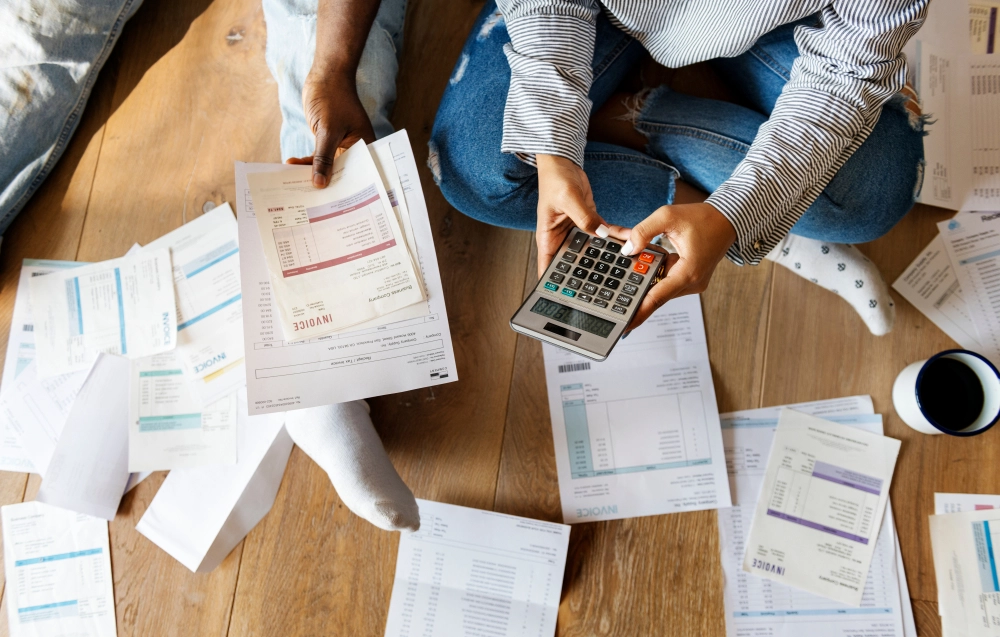If you know that you’re struggling to keep up with your debt repayments, it would be beneficial to set up a plan specifically to be done with your debt. This can help you regain control of your finances.
It may seem unnecessary, but taking an old-school pen-and-paper approach can help you contextualise the problem and find an appropriate solution. Once you’re ready, work through the following four steps to get a grip on your debt.
Tip: Debt consolidation can also help you get out of debt faster – get started here.
1. Work out your debt-to-income ratio
Velmah Nzembela, head of corporate affairs at Assupol Group, notes that debt-to-income ratios are a very useful tool that compares how much you owe each month with how much you earn.
“It’s the percentage of your gross monthly income that goes towards payments for rent, bond, credit cards, and other debt. It’s also the way lenders measure your ability to manage the monthly payments for the money you plan to borrow in future,” says Nzembela.
She explains that to calculate your ratio, you should add up all of your monthly payment commitments, such as school fees, rent, and car payments. Your variable expenses, such as groceries and entertainment, are not included in this calculation.
“Divide this amount by your net monthly salary to get your debt-to-income ratio. Ideally, your income should be greater than your debt. For example, for every R10, R7 should be income and R3 should be debt. This would be a ratio of 7:3,” says Nzembela.
Once you know your ratio value, you will have an idea of where your debt currently stands, and it will be clear how much work lies ahead for you.
2. Set up goals
It’s incredibly important to write down your financial goals. This will give you something to strive towards, and it will help you to remain focused.
Your first goal could be to improve your debt-to-income ratio. But if this isn’t your main concern, you can choose any other goal that resonates with you.
When setting goals, make sure that they’re specific, measurable, and that you give yourself a certain timeframe in which to complete them. This will enable you to be both realistic and accountable.
3. Choose a method for reducing your debt
James Williams, head of marketing at Wonga, says that a useful process to follow is the “snowball method” of debt reduction.
He explains that you should start by committing to pay the minimum payment on every debt. Once you’ve done this, list all of your debt from the smallest balance to the largest.
“Review your budget to find anything extra you can use to reduce your debt. You can then pay the minimum payment plus the extra amount towards the smallest debt until it is paid off,” says Williams.
He explains that once a debt is paid in full, you can add the previous payment from the first debt to the minimum payment on the second-smallest debt. That will be your new payment amount for the latter debt. You can then repeat the process until all of your debt is paid in full.
Alternatively, you can make use of the “avalanche method”. This is approached in the same way as the snowball method, but instead of settling the account with the smallest balance first, you focus on settling the account with the largest interest payments first.
It’s up to you to choose the method you prefer. Once you’ve made your choice, you can work out exactly how long it will take you to repay your debt.
4. Increase your income
The more disposable income you have, the faster you will be able to settle your debt. With South African salaries in many cases failing to keep up with inflation, it’s important to create new income streams. There are two main ways in which you can approach this.
- If you’re employed full-time, take on more responsibility, climb the corporate ladder, and increase your income over time. Alternatively, if you’re a contractor, try to find additional contract work.
- Find ways to monetize your hobby or start a side hustle in a different field. For example, if you’re great at baking, you could sell baked goods over the weekend and market these on social media. This could lead to a new income stream and your debt could vanish sooner.
You can draw up a pros and cons list to determine which of these two would be the right choice for you. You can then outline a plan to get started on your improved revenue stream.
After completing these four steps, you should have a practical plan that will ensure you get out of debt – as long as you follow through with it.
You could also reduce your monthly debt payments by consolidating your debt – find out more.

